67th International Berlin Film Festival

In February, senior and FMST minor, Jerry Qin '17, traveled to the 67th International Berlin Film Festival. He wrote about his trip and has agreed to share his reflections here. Enjoy!
Daily Blog Thursday 2/16/2017:
It must have been the consecutive days staying up until 4AM (10AM Berlin time) to purchase the screening tickets. Or maybe the fact that it is senior spring, a time considered by many to be the most stress of times and the most relaxing of times. Whatever reason is must have been, I carried with me a tiny suitcase and major headache as I walked down the aisle of my 8 hour non-stop flight to Berlin. It certainly did not not help that the man who I would share the next 8 hours of my life had a nasty tendency to exclusively cough to his left-side (the seat that I occupied), an annoyance that was only eclipsed by his tendency to never cover his mouth when coughing. Luckily, 8 hrs goes by fast when you have 400 pages of reading assigned.
Although 2 hrs delayed and now coughing unceasingly myself as well, there was such genuine happiness emitting from me that I probably appeared quite silly standing at the taxi stop wide eyed and jumping with excitement at 8AM in the freezing morning breeze. But I was there in Berlin! For the 67th Berlinale! What a time it is to be alive! I felt like the luckiest film student (and Cinephile) in the world! As I made my way to my host's flat in Kreuzberg, I came to the realization that my flight delay had probably just caused me to miss my 10AM screening at Potsdamer Platz (half hour trek away from the flat). After dropping off my luggage, I now had an additional 3 hours of free time (until 1PM) to address the next pressing issue. How to reduce my fever and this never-ending cough.
There's something about being sick that seems to heighten the senses to a level previously unattainable in healthier times. I tried walking. As I strolled through the Berlin morning, I was reminded of its openness and idiosyncrasies. The high rising street doors of what locals call (the ground level) seem at once inviting and imposing. The street surfaces glistened in the leftover puddles of yesterday's raindrops as brief moments of rare sunshine bless me with its presence. The wide sidewalks of Mehringdamm filled with streets musicians, whose ability to perform in the freezing weather and still somehow catch the incoming euro I was chucking their way never ceased to amaze me. The sound of soft and gentle German spoken around me were such a stark contrast to the gross generalizations of the language that permeated the states. But more striking was the diversity of the sounds on streets, from fluid Parisian French and cantankerous Cantonese bickerings, to Dutch and Turkish infused German, it didn't take long to feel the cosmopolitan aura of my surroundings.
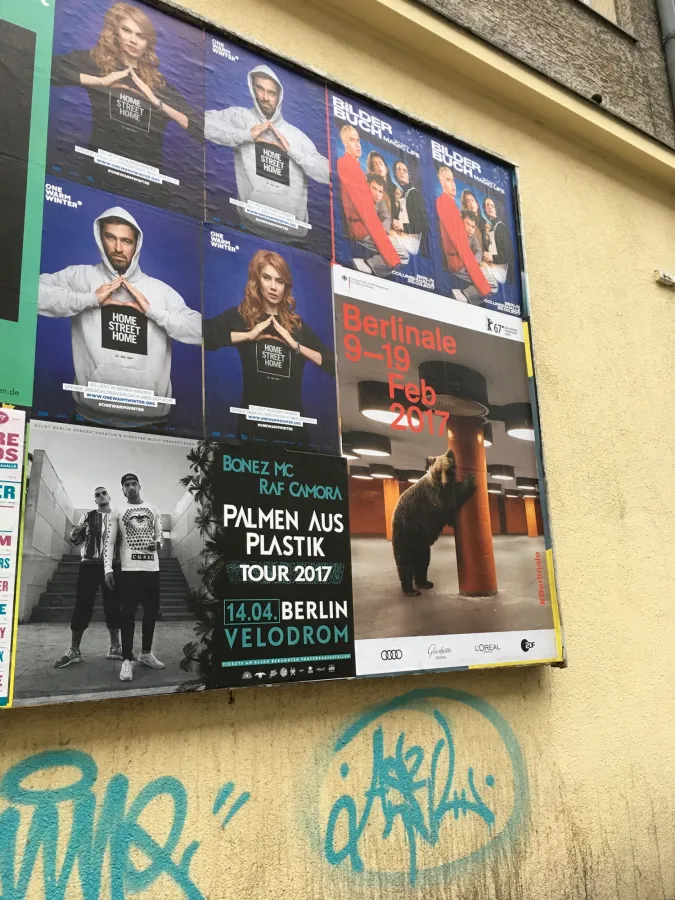
(Posters of Berlinale populate every street corner)
Alas, I stopped walking. Stopped somewhere between an old church and a latte place. My head wouldn't stop throbbing and I desperately needed many shots of espresso for I had been awake for more than 24 hrs by that time and I had three more screenings in the next 10. As I made my way to the first venue, Kino International, I realized that all around the city were para-texts of the festival; on vending machines, public transit, and every single webpage you open using the limited free wi-fi to try and find where you are going. Internationale itself is a quite imposing building. At first glance, one might think it must have at least 5 or 6 large theaters inside. But in fact there's only one gigantic screening room that covers the entirety of the second floor and extends into the third. Walking into the hallowed halls of the Internationale reminded me of the exhibitionistic past of cinema that had been largely missing from my cinema-going experiences in the US. The spectacle of the film in the US has been (for me) so focused on "the illusion" on screen, that I had become numb to the performance of the cinema and all the concrete acts associated with the show offscreen.
MY first screening at the 67th Berlinale was a Panorama documentary film called “No Intense Agora” (In the Intense Now), a documentary idea stemming from the director's discovery of his mother's past footage during her travels to China during the beginning of the Cultural Revolution which the director would take as a trailhead to ignite his exploration of other societies in upheaval. From the Brazilian coup of 1964 to the Prague Spring of 1968. Director Joao Moreira Salles seeks to explore these parallel stories of revolution and their subsequent failure. Though artistically weaved and skillfully edited, the runtime left half of the theater nodding off before they had a chance to appreciate the content on screen. And for those who had not overdosed on the espresso beforehand (like myself), nodding off is not a choice but a necessity. I had about 30 mins to run from Internationale to the Kino Colosseum up in Schoenhauser Allée. I was sick and coughing still but somehow watching the Red Guards singing in unison to Mao’s godly portraits gave me the energy I needed to sprint up the sidewalks of Berlin, maybe for those moments I was living in the intense now.
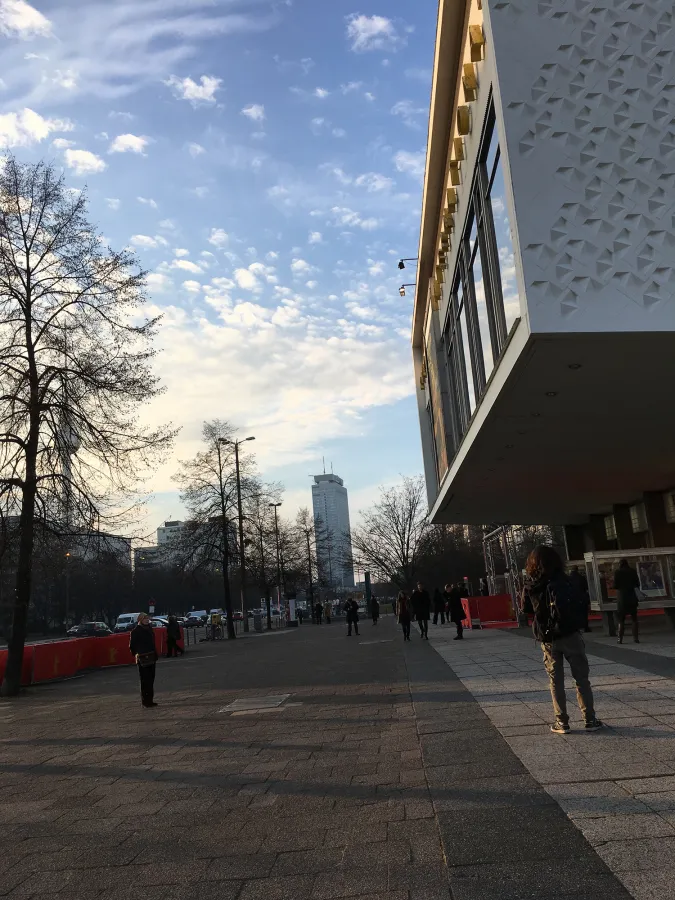
(Side-view of the Internationale)
Next up was the Berlinale Shorts IV “Utopia Unplugged”, a series of short films selected and then grouped into various themes agreed upon the lead organizers. Though I never had much interest nor knowledge of short films, I had intentionally diversified my screening options for the day across Panorama, Shorts, and Competition films to observe the diverse offerings of the festival as well as the differences in the audience of each. I found the short film “The Boy from H2” to be particularly thought-provoking, both about the art of documentary making as the subject of Palestinian occupation’s effect on children. The short film documents the life of 12 year old Palestinian Muhammad Burqan who lives in H2 (the divided region of Hebron, the largest city in the West Bank) with large family. The most amazing aspect of the shorts was the ability to see the director of each film come on stage after the screening to field questions from the crowd. It was an extremely liberating experience to be able to have your curiosity and concerns quenched by the author of the material in person directly after viewing their work. Though at times contentious and at times laudatory, the genuine love for cinema and interest in the stories behind them fueled my passion for the cinema more than ever.
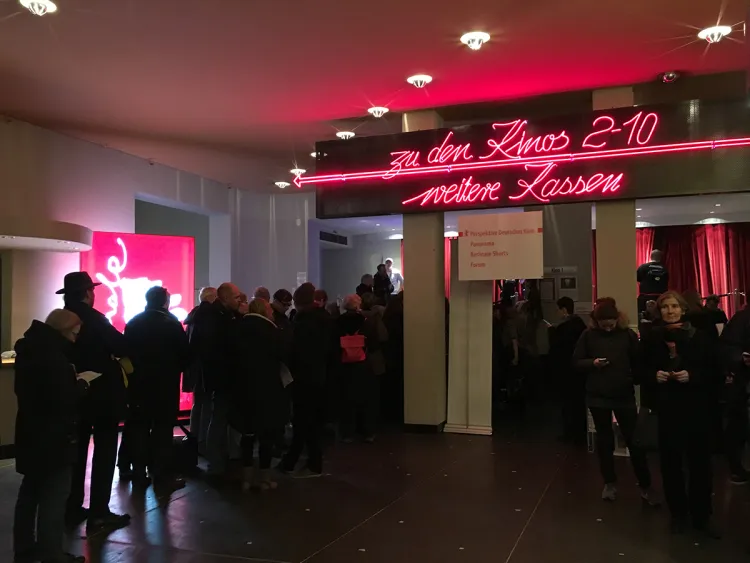
(The inside of Kino Colosseum with lines of cinephiles waiting to get in)
For the final screening I had a bit more time on my hands, a whole two hours to make my way to Friedrichstadt Palast in the heart of Mitte for a 9:30PM screening. With that much extra time, I had to go out of my way to go to “Mustafa’s Gemuese Kebab” in Kreuzberg to grab a basic Berlin necessity, the doner kebab, or what the chef de cuisine called “Turkish Heaven”.
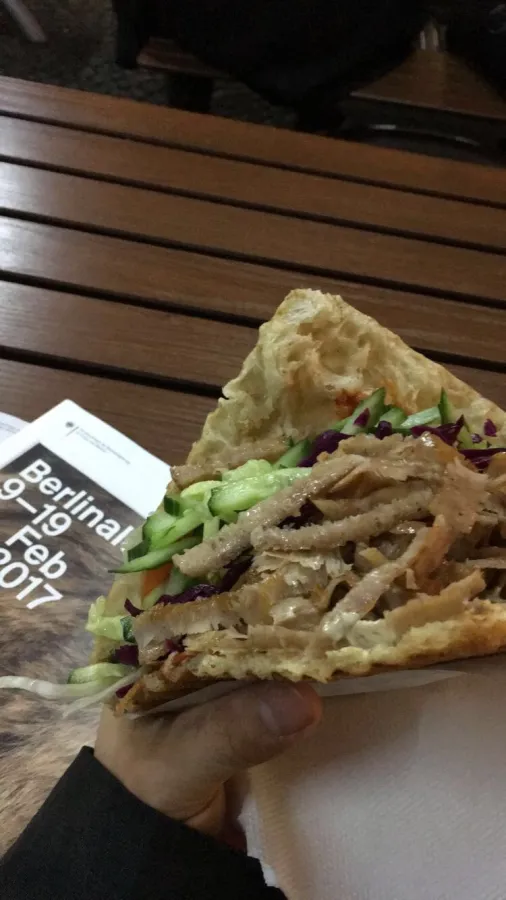
Walking into Friedrichstadt Palast shattered my conception of what a “theater” could look like in the cinematic sense, hundreds of seats line the 5 story tall building with multiple levels of seating and seems to go on forever as your eyes move up. Two large curtains the size of football fields hang over the silver screen, and to think I thought the Internationale was huge just a few hours ago. Colo, a film by Portuguese director Teresa Villaverde, was the first competition film I had seen at the Berlinale and its venue definitely lived up to expectations. As the curtains over the silver screen parted like the Red sea, I could not move my eyes from the theater that was about to unfold before me. But with the help of the movie, I was soon nodding off and swaying my head unconsciously from side to side. Villaverde’s competition piece was intentionally and relentlessly boring. The inability to have anything happen onscreen mirrors the message of the film, the director’s lament at the social degeneration of the characters and their utter inability to make genuine connections with their loved ones. Nonetheless, everything about “Colo” was carefully constructed and coherent in conception and execution. If you are a fan of the slow cinema, I would definitely recommend this film for you.
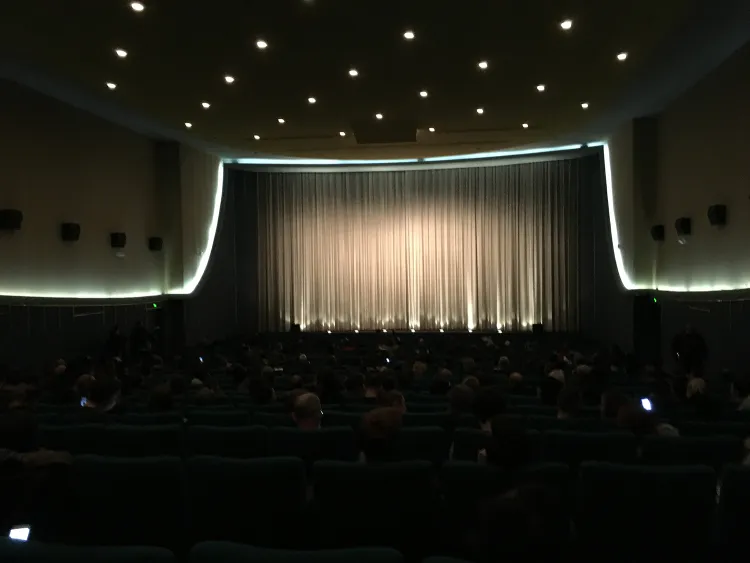
(Inside of theater)
Daily Blog Friday 2/17/17:
Friday came and went abruptly. As I made my way back to the flat in Kreuzberg it was already half past 1AM, and having stayed up for more than 36 hours at that point I was ready to sink into the nearest pillow never to resurface again. Alas, 13 hours later I awoke slowly to the sound of February Berlin showers gently tapping the windowpane of the 7th floor balcony. It was 3:30PM and it seemed that time (and sleep) has been the best medicine for my fever.
I was in no hurry to leave the apartment, for I had felt it extremely rude on my part to not have at least sat down for one meal or tea time with my German hosts since I arrived nearly a day and a half ago and I wasn’t about to continue the rudeness. I approached my host’s study and introduced myself and the course of next few days in Berlin and she cordially invited me to a cup of espresso and a dose of hardcore anti-cold medicine. Luckily for me, her husband just happens to a be a pharmacist of twenty years. It was a German homeopathic pill called Gelomyrtol, I had never heard of it but I gulped it down gladly. In turns out that my host is actually from Valencia, Spain but moved to Berlin with her German husband where they have been living for more than a decade now. We chatted profusely about the vegan bakeries of Berlin and the state of the european union. She asked me about the reactions of youth in America to the rise of Trump and the US interpretations of Brexit. And I asked how she stands traditional German cuisines being from Valencia.
I did not have any screenings planned for the evening until a 9:30PM showing of a competition film at Friedrichstadt Palast, so I decided to pop my head into the 6:30PM director Q&A session at Potsdamer Platz with the leading directors of the Berlinale Shorts program. It turned out to be one of the best decisions of my entire trip.
Attending the director Q&A, which was free and open to the public, gave me a sneak peek into the institutions and people who produce, distribute and exhibit the “texts” (films) as well as a glance at the manner in which the audiences receive them. For the first time, I began to detect the extension of film festivals beyond that of just the cinematic exhibition. I observed firsthand the ability of film festivals to provide an important institutional framework for the cultivation of cinematic taste, cultural power, industry standards, and more importantly the negotiation of postcolonial global relations. Many of the directors speaking on the panel had come up within the Berlinale Talents and development programs meant to nurture and sponsor young cinematic talent from around the globe, and others were veterans of the festival who spoke radiantly of their past participation in the Berlinale and the cinematic techniques and personal relationships they forged there. What was well hidden from the sights of sounds of the cinematic and artistic was the EFM (European Film Market), which was in operation a few blocks down the street from Potsdamer Platz and had a unusually large collection of men in suits that seemed more stereotypical of Munich than Berlin. I was very curious about the balance between such behind-the-scenes negotiations with those in front of the screen: namely the discussion of the audience and the construction or deconstruction of what Habermas calls the public sphere.

(Outside of Potsdamer Platz)
But alas my fever had not died and I had a screening to run to, so I decided to leave the theoretical inquiries until after my return to Swarthmore. Once again I find myself walking on the silently loud streets of central Berlin as I made my way from Alexanderplatz towards Friedrichstadt Palast. Brushing shoulders with boisterous group of youngsters conversing in French heading out into the fun-filled night yet to come, I rejoiced my opportunity for peace and reflection at my next screening.
My only screening of the evening was the Korean film “Bamui Haebyun-eoseo Honja” (On the Beach Alone at Night) by famed Korean auteur Hong Sangsoo, a veteran of the Berlinale with his film Night and Day in 2008 and Nobody’s Daughter Haewon recently in 2013. The film centers around a celebrated actress, Younghee, who decides to take some time from her career after an affair with a married man: a famed director who she had previously worked on a film with. The story takes place in Hamburg, Germany and the Korean coastal town of Gangneung, on two beaches but neither of the scene happens at night. The film focuses much of its cinematic pondering on the meaning of love and its place in our lives and in the arts. And in typical Hong Sangsoo fashion, the audience is left feeling that the answers to those question had just slipped from their grasp. As always, the Korean national liquor Soju serves as a main character in this film for both plot and commercial purposes. Kim’s performance as Younghee made this one of my favorite film of the festival, her subtle combination of self-pity with a painfully honest and alcohol-infused rant made a mostly conversational scene one of the most visceral moments I have seen on screen this year. If you are a fan of the slow-cinema and a ponder of love’s meaning, this pale-toned international requiem for love is the right film for you.
Daily Blog Saturday 2/18/17:
My last full day in Berlin was a fun film-filled day with four screenings from the break of dawn to midnight premieres. It was an early day for me as I got dressed for the 9:30AM screening. Sunday mornings in Berlin are quiet, almost too quiet. Streets devoid of noise and and any leftover debris create a ghost like feeling. But I scrolled into a local coffee shop in Kreuzberg, the friendly chatter of young parents feeding coffee to their children soon erased all the silence with laughters of joy that transcended all language barriers that I had.
The U-bahn to Friedrichstadt Palast was unusually late (by German standards), causing me to miss the next connecting bus. In the span of three days, I was once again called upon to channel my inner Bolt as I sprinted through the empty streets of early Berlin. Luckily I wasn’t too out of shape and made into the theater just minutes before the closing of the entrance. Once again the punctual stereotype proves to be true, they do indeed not allow audience after the showing begins. The grand entrance into the Palast never ceases to amaze me with it high searching ceilings in pitch dark as if a night sky devoid of stars and signs of life. The curtains would again part like the Red Sea. The show begins.
The first film of the morning was the only animated motion picture to be chosen in competition at the Berlinale this year. Former landscape painter turned director, Liu Jian, crafts a vivid story of modern China with his sharp and introspective animations in his new film “Hao Ji Le” (Have A Nice Day). Set in an unnamed city in southern China and tied together by a large bag containing a million yuan in cash, the film is a mix of Tarantino’s Pulp Fiction and the Coppola’s Godfather trilogy in the form of an animated Chinese crime thriller. The plot draws a group of individuals from diverse backgrounds and differing motives in a concert of bloody confrontations. There are philosophising gangster bosses, disillusioned punk youth, ailing hitman, and men and women are just struggling to survive the day to day demands in an ever changing society that has left a large portion of its population behind. Hao Ji Le is a black satire that visually looks very much like A Scanner Darkly in a Fargo-esque scenario where a bunch of people in a small town get mixed up in a violent chase for a large bag of money.
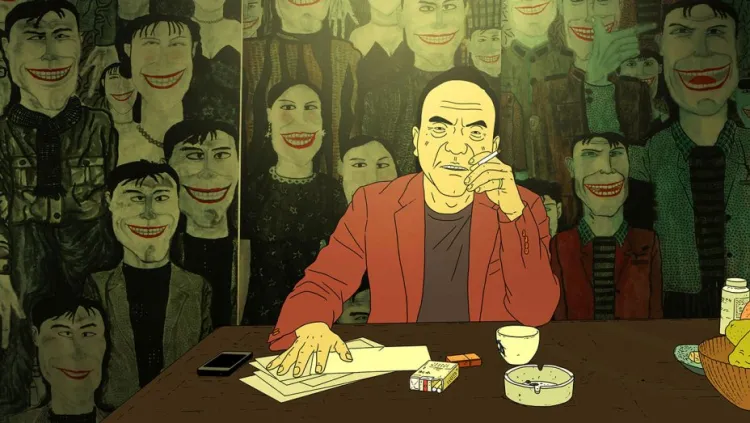
Though simply composed and rarely political in its content, this film one of the best I have seen in competition so far because of its thoughtful humor and clarity. The colorful characters and their stoic humor holds up a magnifying glass to the life, attitudes and social realities or a severely insecure nation in transition. The reduced realism of the film’s animation also mirrors the almost fantastical rise of China’s economy and relates the mood of modern China caught between past and present with an accuracy that would be difficult even for a non-animated film. I would definitely recommend this animated feature to anyone interested in the current state of modern China and the future of global capitalism, it will be 77 minutes of your life well spent. But as much as I enjoyed the film, it lacked the political punch I was hoping for and seemed like a missed opportunity to tackle some of the more pressing issues with modern Chinese culture (or the lack of it). As for those proponents of the Chinese dream, it is best to avoid this feature or risk having your dreams smashed in the opening scene.
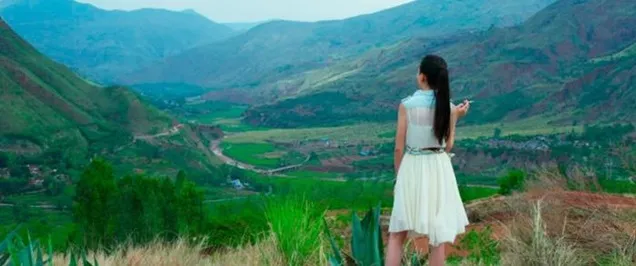
It would be quite sometime before I could get the moving images and the colorful character of this animation out of my head, but I knew China’s modern struggles was a subject that I would not mind keeping in mind as I entered the touristy shopping centers of Alexanderplatz for the screening of my next film. Featured in Panorama this year, Ciao Ciao, is as much a story of China’s liminal state as it is about the a city girl’s inability to shed her country roots. The poetic movements of director Song Chuan’s camera takes a hard look at both the generational and regional disparities in a country whose identity has been built on forced conformity and unity. Watching Ciao Ciao attempt to acclimate to rural life in Yunnan province with her Louis Vuitton bag and smartphone in hand while the camera pans through the natural beautiful winding gorges transforms this familiar story of the prodigal daughter returning home into a patient and poignant look at growing pains of a nation in caught in progress. Though each character has found their own ways of dealing with unhappiness and uncertainty in the countryside; sex, alcohol, or adultery, the film never ceases to focus on their discontent as it is zooms into the their minute facial expressions. With each passing scene, the attention to detail intensifies as Ciao Ciao pouts and scoffs her way through the story. The finesse of editor Jean-Marie Lengelle (Blue is the Warmest Color) shines through in a film that turns out to be extraordinary without ever seeming like it is.
Up until this point I have tried my best to diversify the range of I films I saw, from Panorama to in Competition, as well as Berlinale shorts. But there was still so many selections that I had not experienced at this point and I was keenly aware of that gap. For this last screening, I wanted to just walk into the ticketing booth and buy a ticket to whatever was left on that day. And that’s how I ended up at the screening of a Forum film called “Mzis qalaqi” (City of the Sun), a Georgian documentary about the collapse of a Manganese town in the city of Chiatura. It turned out to be the best film I saw at the entire festival.
At one point in time in the middle of the 20th century up to 50% of all the manganese, a vital industrial metal, was mined in the Georgian town of Chiatura. Today, is a ghost town with more vacant buildings than living residents. The documentary is a pensive opera of the lives of those few remaining residents and their daily lives. From the music teacher who dismantles old soviet granaries so he can sell off the iron girders on the side to local miner who real passion lies in Shakespeare and amatuer theater, director Rati Oneli breathes a hint of life into a forgotten city. In a city that never feels sunshine, it is only the people and their love for life that generates the warmth. Oneli’s debut documentary digs up what no mining machinery can for his camera brings to the surface the most valuable of resources, compassion.



